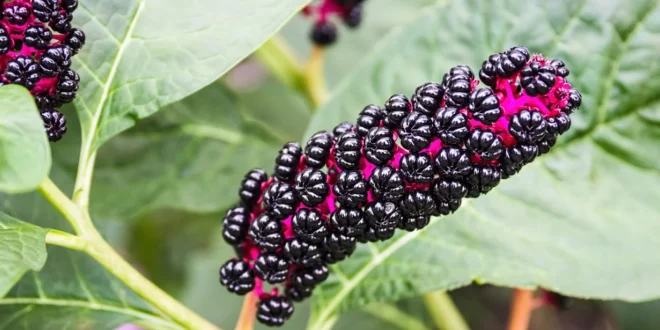Are you familiar with pokeweed? Also known as American nightshade, inkberry, or weed berry, this plant has exciting applications in folklore and medicine. Despite its attractive appearance and potential for culinary experimentation, it’s vital to remember that the whole plant is poisonous to humans.
We all know about the risk of consuming deadly mushrooms, but what might surprise you is that even seemingly benign vegetation can kill if handled or consumed improperly. Let’s explore why pokeweed should be treated cautiously – from what makes it harmful to how you can stay safe when encountering it outdoors.
What is pokeweed, and where does it grow?
Pokeweed is an exciting plant with many names, such as pokeberry and inkberry, and is known for its deep purple berries. It has a long history of being used in folk medicine and as a food source in springtime. However, it is essential to be careful when handling it as all parts of the plant are toxic and can cause internal bleeding if eaten raw.
Pokeweed grows throughout the United States, often along roadsides and in woodland areas, preferring well-drained soil with plenty of sun. Its flowers turn into bright purple-coloured berries that attract birds looking to feed on them from summer into autumn until they eventually become poisonous. With its unique appearance and persistent nature, pokeweed is an exciting wildflower that should be appreciated from afar.
What are the dangers of pokeweed poisoning in humans?
Pokeweed is considered toxic to humans and animals, as it contains substances like saponins, alkaloids, and glycosides that can cause serious health problems if consumed. Symptoms of pokeweed poisoning vary depending on how much was ingested but can range from mild discomforts, such as nausea or vomiting, to more severe symptoms, like intense abdominal pain and diarrhoea. Other signs of toxicity may include difficulty breathing, seizures, and even death in extreme cases.
It is important to note that berries are not the only part of the plant which carries a risk; all parts of the plant should be avoided as they are potentially harmful when ingested. Additionally, animals should never consume pokeweed either – it has been known to cause paralysis in cows and sheep that have been unfortunate enough to eat it. For these reasons, it’s essential to know how to get rid of pokeweed and how to avoid it in the first place.
How do you identify pokeweed plants in your backyard or neighbourhood park?
Pokeweed can be relatively easy to identify, as its long purple stems usually stand out from other vegetation. Its leaves are pointed and have a waxy texture, often green on top with paler undersides. During the summer, pokeweed will produce clusters of white or pink flowers, eventually becoming the deep purple berries mentioned earlier.
If you suspect you’ve found a patch of pokeweed growing in your backyard – or anywhere else, for that matter – it’s best to leave it alone and enjoy it from afar. It’s also essential to inform others nearby about its potential hazards so everyone can stay safe and healthy.
What are the symptoms of pokeweed poisoning, and what should you do if someone has eaten it accidentally or on purpose?
It is always best to avoid caution if you suspect someone may have eaten pokeweed. Poisoning symptoms can be challenging to diagnose, so seeking medical attention immediately is essential if you think they may have been poisoned. Some common signs and symptoms include abdominal pain, vomiting, diarrhoea, dizziness, confusion, and difficulty breathing.
The most severe cases of pokeweed poisoning can cause internal bleeding in addition to all the other ailments mentioned above. If a person has consumed large amounts or any part of the plant raw, professional medical help must be sought as soon as possible.
Is there any treatment for pokeweed poisoning, and can it be fatal if not treated properly?
If pokeweed poisoning is suspected, seeking medical attention as soon as possible is crucial. Treatment for pokeweed poisoning usually involves intravenous fluids and electrolytes and monitoring the patient’s vital signs. Additionally, activated charcoal may be administered to absorb any remaining toxins from the stomach.
In extreme cases, hospitalization may be necessary to monitor for potential complications such as internal bleeding or seizures. Unfortunately, if not treated quickly or adequately enough, pokeweed poisoning can be fatal, so emergency help must be sought immediately if you suspect this plant has poisoned someone.
With its unique appearance and persistent nature, pokeweed should never be seen as anything more than an attractive wildflower – one we should admire from a distance and never attempt to consume. While its berries may look appetizing, the risks associated with eating them are too significant to ignore. Educating ourselves on this plant is critical to keep our families safe and healthy.
Conclusion
By being mindful of pokeweed’s potentially toxic qualities, we can help ensure that no one ends up ingesting it accidentally – or, even worse, intentionally. As always, prevention is the best form of protection regarding potential sources of environmental danger. Exercising caution and avoiding contact with pokeweed can help keep yourself and those around you safe from harm.
 HammBurg Be informed with latest news, reviews, entertainment, lifestyle tips, and much more.
HammBurg Be informed with latest news, reviews, entertainment, lifestyle tips, and much more.



